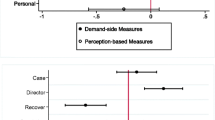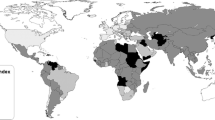Abstract
Corruption is a widespread phenomenon in many developing and transitional economies. China is a country in profile both in the prevalence of corruption and in its attempts to root out corruption. The recent anti-corruption campaign in China, which started in December of 2012 when President Xi Jinping took power, is unprecedented in its magnitude and time length. It has had lasting impact on the functioning of the Chinese bureaucracy and on the behavior of firms and consumers. It also provides unusual amount of data to study the causes and consequences of corruption, which will have implications for other countries and economies. In this review, I discuss the definition and measurement of corruption with a particular focus on the measurements that highlight the city-level heterogeneity of corruption in China and present simple frameworks to understand the determinants of corruption by government officials and the causes and consequences of corruption and anti-corruption. I summarize the key findings regarding how the anti-corruption campaign affects the behavior of a host of decisions makers in the economy, including firms and bureaucrats, and on the resource allocation in general, and argue that the lessons from China’s anti-corruption campaign are useful to other developing countries.
Similar content being viewed by others
Notes
See Olken and Pande (2011) for a detailed review.
See Sect. 4.1 for a detailed description of Xi’s anti-corruption campaign.
See the corruption perception index compiled by Transparency International.
See World Bank (2020) for a detailed manual to fight corruption in the public sector.
See Stephenson (2015) for a comprehensive review of the literature on the relationship between democracy and corruption.
Several other countries have also launched in recent anti-corruption campaigns, including Brazil, South Korea, India, Nigeria, Vietnam, among others.
We can easily allow \(Q(\cdot )\) to depend on the bribe and anti-corruption campaign intensity.
Alternatively, we can assume that the bureaucrats choose only the regulatory regime \(r\in \left\{ H,L\right\}\) and each firm chooses \(b_{i}\) and \(p_{i}\) given the regulatory regime chosen by the bureaucrats. In such a case, the only way anti-corruption campaigns will affect the level of bribes, and firm performance is that the bureaucrats choose a different regulatory regime. For simplicity, we have assumed only two regulatory regimes, H and L; but we assume that there is a continuum of regulatory regimes indexed by \(\kappa ,\); then, similar qualitative conclusions can be obtained in this alternative model as well.
Cong et al. (2019) document that the credit stimulus of 2009–2010 favored state-owned firms and firms with lower returns to capital.
References
Agarwal, S., Qian, W., Seru, A., & Zhang, J. (2020). Disguised corruption: Evidence from consumer credit in china. Journal of Financial Economics, 137, 430–450.
Antonossava, A., Bertrand, M., & Mullainathan, S. (2008). Misclassification in targeted programs: A study of the targeted public distribution system in Karnataka, India. Harvard University.
Barwick, P. J., Fang, H., & Li, S. (2023). Dining on the government’s dime vs. dining on your own dime. Working Paper.
Brueckner, M. (2021). Democracy and corruption. Journal of Risk and Financial Management 14(10).
Cai, H., Fang, H., & Xu, L. C. (2011). Eat, drink, firms, and government: An investigation of corruption from entertainment and travel costs of Chinese firms. Journal of Law and Economics, 54, 55–78.
Chen, T., & Kung, J.K.-S. (2019). Busting the “princelings’’: The campaign against corruption in China’s primary land market. The Quarterly Journal of Economics, 134(1), 185–226.
Chu, Y., Kuang, W., & Zhao D. (2019). The effect of the anti-corruption campaign in China: Evidence from housing transactions.
Cong, W., Gao, H., Ponticelli, J., & Yang, X. (2019). Credit allocation under economic stimulus: Evidence from china. Review of Financial Studies, 32(9), 3412–3460.
Deng, Y., Wei, S.-J., Wu, J., & Zhang, R. (2023). Estimating the unofficial income of officials from housing purchases: The case of China. forthcoming, Management Science.
Di Tella, R., & Schargrodsky, E. (2003). The role of wages and auditing during a crackdown on corruption in the city of Buenos Aires. Journal of Law and Economics, 46, 269–300.
Ding, H., Fang, H., Lin, S., & Shi, K. (2020). Equilibrium consequences of corruption on firms: Evidence from China’s anti-corruption campaign. Working Paper 26656, National Bureau of Economic Research.
Faccio, M. (2006). Politically connected firms. American Economic Review, 96(1), 369–386.
Fang, H., Gu, Q., & Zhou, L.-A. (2019). Gradients of power: Evidence from the Chinese housing market. Journal of Public Economics, 176, 32–52.
Fang, H., Li, Z., Xu, N., & Yan, H. (2023). Firms and local governments: Relationship building during political turnovers. Review of Finance, 27(2), 739–762.
Fang, H., Wu, J., Zhang, R., & Zhou, L.-A. (2022). Understanding the resurgence of the SOEs in China: Evidence from the real estate sector. Working Paper 29688, National Bureau of Economic Research.
Fisman, R. (2001). Estimating the value of political connections. The American Economic Review, 91(4), 1095–1102.
Fisman, R., & Golden, M. A. (2017). Corruption: What Everyone Needs to Know. Oxford University Press.
Fisman, R., & Wei, S.-J. (2004). Tax rates and tax evasion: Imports in china. Journal of Political Economy, 112, 471–496.
Gentzkow, M., Glaeser, E. L., & Goldin, C. (2006). The rise of the fourth estate: How newspapers became informative and why it mattered. In E. L. Glaeser & C. Goldin (Eds.), Corruption and Reform: Lessons from America’s Economic History (pp. 187–206). University of Chicago Press.
Gorodnichenko, Y., & Peter, K. S. (2007). Public sector pay and corruption: Measuring bribery from micro data. Journal of Public Economics, 91, 963–991.
Hsieh, C.-T., & Moretti, E. (2006). Did Iraq cheat the united nations? underpricing, bribes, and the oil for food program. Quarterly Journal of Economics, 121, 1211–1248.
Huntington, S. P. (1968). Political Order in Changing Societies. Yale University Press.
Kaufmann, D., & Wei, S.-J. (1999). Does ’grease money’ speed up the wheels of commerce? Working Paper 7093, National Bureau of Economic Research.
Ke, B., Liu, N., & Tang, S. (2022). Does anti-corruption regulation improve the performance of state-controlled firms? Evidence from china.
Khurana, R., Fisman, R., Galef, J., & Wang, Y. (2012). Estimating the value of connections to vice-president Cheney. The B.E. Journal of Economic Analysis & Policy, 13(3), 1–20.
Khwaja, A., & Mian, A. (2005). Do lenders favor politically connected firms? rent provision in an emerging financial market. Quarterly Journal of Economics, 120(4), 1371–1411.
Klitgaard, R. (1991). Gifts and bribes. Strategy and Choice (pp. 419–435).
La Porta, R., Lopez-de Silanes, F., Shleifer, A., & Vishny, R. (1999). The quality of government. Journal of Law, Economics, and Organizations, 15, 222–279.
Laffont, J.-J., & Tirole, J. (1991). The politics of government decision-making: A theory of regulatory capture. Quarterly Journal of Economics, 106(4), 1088–1127.
Leff, N. H. (1964). Economic development through bureaucratic corruption. The American Behavioral Scientist, 8(2), 8–14.
Li, B., Wang, Z., & Zhou, H. (2022). China’s anti-corruption campaign and credit reallocation from SOEs to non-SOEs.
Li, H., & Zhou, L.-A. (2005). Political turnover and economic performance: the incentive role of personnel control in china. Journal of Public Economics, 89(9), 1743–1762.
Lin, C., Morck, R., Yeung, B. Y., & Zhao, X. (2016). Anti-corruption reforms and shareholder valuations: Event study evidence from China. Technical Report Working Paper No. 22001, National Bureau of Economic Research.
McMillan, J., & Zoido, P. (2004). How to subvert democracy: Montesinos in Peru. Journal of Economic Perspectives, 18(4), 69–92.
Navot, D., Reingewertz, Y., & Cohen, N. (2016). Speed or greed? High wages and corruption among public servants. Administration & Society, 48(5), 580–601.
Niehaus, P., & Sukhtankar, S. (2013). Corruption dynamics: The golden goose effect. American Economic Journal: Economic Policy, 5(4), 230–269.
Olken, B. A. (2006). Corruption and the costs of redistribution: Micro evidence from indonesia. Journal of Public Economics, 90, 853–870.
Olken, B. A. (2007). Monitoring corruption: Evidence from a field experiment in Indonesia. Journal of Political Economy, 115, 200–249.
Olken, B. A., & Barron, P. (2009). The simple economics of extortion: Evidence from trucking in Aceh. Journal of Political Economy, 117, 417–452.
Olken, B. A., & Pande, R. (2011). Corruption in developing countries. Annual Review of Economics, 4, 479–505.
Pei, M. (2018). How not to fight corruption: Lessons from china. Daedalus, 147(3), 219–220.
Peltzman, S. (1976). Toward a more general theory of regulation. Journal of Law and Economics, 19(2), 211–244.
Peng, L., & Tang, H. (2023). Politics and asset prices: China’s anti-corruption campaign and prices of luxury homes in Beijing. Working Paper.
Qian, N., & Wen, J. (2015). The impact of xi Jinping’s anti-corruption campaign on luxury imports in China. Preliminary Draft, Yale University.
Reinikka, R., & Svensson, J. (2004). Local capture: Evidence from a central government transfer program in Uganda. Quarterly Journal of Economics, 119, 679–706.
Reinikka, R., & Svensson, J. (2005). Fighting corruption to improve schooling: Evidence from a newspaper campaign in Uganda. Journal of the European Economic Association, 3, 259–267.
Reinikka, R., & Svensson, J. (2011). The power of information in public services: Evidence from education in Uganda. Journal of Public Economics, 95, 956–966.
Rock, M. T. (2016). Corruption and Democracy. In Dictators, Democrats, and Development in Southeast Asia: Implications for the Rest. Oxford University Press.
Rose-Ackerman, S. (1999). Corruption and Government: Causes, Consequences, and Reform. Cambridge University Press.
Shleifer, A., & Vishny, R. (1993). Corruption. Quarterly Journal of Economics, 108(3), 599–617.
Stephenson, M. C. (2015). Chapter 4: Corruption and democratic institutions—A review and synthesis. Edward Elgar Publishing.
Stigler, G. J. (1971). The theory of economic regulation. Bell Journal of Economics and Management Science, 2(1), 3–21.
Tirole, J. (1996). A theory of collective reputations (with applications to the persistence of corruption and to firm quality). The Review of Economic Studies, 63(1), 1–22.
Wei, S.-J. (2000). How taxing is corruption on international investors? Review of Economics and Statistics, 82(1), 1–11.
Wei, S.-J. (2000). Local corruption and global capital flows. Brookings Papers on Economic Activity, 2000(2), 303–354.
World Bank. (2020). Enhancing government effectiveness and transparency: The fight against corruption. Technical report.
Zingales, L. (2017). Towards a political theory of the firm. Journal of Economic Perspectives, 31(3), 113–130.
Acknowledgements
This review is prepared for a special issue of International Tax and Public Finance, and is based on a keynote talk I gave in the International Institute Public Finance (IIPF) Annual Congress at Linz, Austria (August 2022). I would like to thank the Congress Scientific Committee chairs Anne Brockmeyer and Juan Carlos Suarez Serrato for giving me the opportunity to synthesize my understanding of the important topic of corruption and anti-corruption in emerging economies. I am grateful to Hongbin Cai and Lixin Colin Xu with whom I collaborated on my first paper on the measurement of local corruption in China (Cai et al., 2011). My research on the topic benefits from the insights from my coauthors, Panle Jia Barwick, Hongbin Cai, Haoyuan Ding, Quanlin Gu, Shi Kang, Shangjun Li, Shu Lin, Ming Li, Zhe Li, Wei Xiong, Nianhang Xu, Hongjun Yan, Lixin Colin Xu, and Li-An Zhou. Any errors are my own.
Author information
Authors and Affiliations
Corresponding author
Additional information
Publisher's Note
Springer Nature remains neutral with regard to jurisdictional claims in published maps and institutional affiliations.
Rights and permissions
Springer Nature or its licensor (e.g. a society or other partner) holds exclusive rights to this article under a publishing agreement with the author(s) or other rightsholder(s); author self-archiving of the accepted manuscript version of this article is solely governed by the terms of such publishing agreement and applicable law.
About this article
Cite this article
Fang, H. Measurements, determinants, causes, and consequences of corruption: lessons from China’s anti-corruption campaign. Int Tax Public Finance 31, 3–25 (2024). https://doi.org/10.1007/s10797-023-09803-y
Accepted:
Published:
Issue Date:
DOI: https://doi.org/10.1007/s10797-023-09803-y




